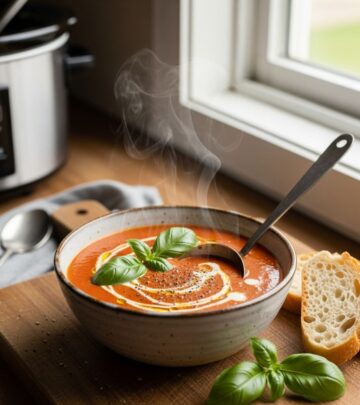The Best Marinara Sauce Yet: A Complete Homemade Guide
Master the art of homemade marinara sauce with this rich, easy-to-follow recipe, packed with pro tips and answers to your sauce questions.

There is something timeless and unmistakably comforting about homemade marinara sauce. Whether you’re dressing a bowl of pasta, ladling it onto pizza, or using it as a base for further dishes like bolognese, a good marinara anchors the meal with familiar, vivid flavor. This guide will walk you through an easy, richly flavored recipe that’s beloved by home cooks and even the pickiest eaters—plus, provide everything you need to know to master it with confidence in your own kitchen.
What is Marinara Sauce?
Marinara sauce is a classic Italian tomato-based sauce, known for its bright, herby flavor and simplicity. Unlike heavier tomato sauces, marinara comes together quickly and relies on quality canned tomatoes, herbs, aromatics, and olive oil to develop its character. The result is a versatile sauce that pairs beautifully with spaghetti, meatballs, and much more.
Ingredients
- Stewed tomatoes (two 14.5-ounce cans, undrained): These form the flavorful base of the sauce and give it a luscious, chunky texture.
- Tomato paste (one 6-ounce can): This concentrates the tomato flavor and enhances the sauce’s thickness and richness.
- Fresh parsley (about 4 tablespoons, chopped): Brings a bright, fresh note. Dried parsley works as a substitute (use 1 tablespoon plus 1 teaspoon).
- Garlic (1 large clove): Essential for depth and that signature Italian aroma.
- Dried oregano (1 teaspoon): Traditional in marinara, adding an earthy herbaceousness.
- Salt (1 teaspoon): Balances acidity and heightens the tomato and herb flavors.
- Ground black pepper (1/4 teaspoon): For a subtle warmth.
- Onion (1/3 cup, finely diced): Sautéed onion provides natural sweetness and body.
- Olive oil (6 tablespoons): A quality extra-virgin olive oil will build the sauce’s foundation.
- White wine (1/2 cup): Adds acidity, complexity, and helps meld the flavors.
Ingredient Table
| Ingredient | Amount | Preparation | Substitution |
|---|---|---|---|
| Stewed tomatoes | 2 x 14.5 oz cans | Undrained | Canned whole or crushed tomatoes |
| Tomato paste | 6 oz | None | Double up on paste for thicker sauce |
| Fresh parsley | 4 tbsp chopped | Chopped | 1 tbsp + 1 tsp dried parsley |
| Garlic | 1 clove | Minced | 1/2 tsp garlic powder (in a pinch) |
| Dried oregano | 1 tsp | None | Italian seasoning |
| Salt | 1 tsp | None | To taste |
| Black pepper | 1/4 tsp | Fresh ground preferred | Crushed red pepper for heat |
| Onion | 1/3 cup | Finely diced | Shallot or omit for less sweetness |
| Olive oil | 6 tbsp | None | Any neutral oil (but flavor will differ) |
| White wine | 1/2 cup | None | Chicken broth, vegetable stock, or omit |
Step-by-Step Instructions
- Prepare the tomato mixture: In a food processor, add the stewed tomatoes (including their juice), the tomato paste, chopped fresh parsley, a peeled clove of garlic, dried oregano, salt, and ground black pepper. Blend these ingredients until you have a smooth, cohesive mixture.
- Prepare the aromatics: Peel and finely dice the onion, setting it aside for sautéing.
- Sauté the onion: In a large skillet or saucepan, heat the olive oil over medium heat. Once the oil is shimmering, add the diced onion. Cook, stirring occasionally, until the onion is translucent and tender (about 5 minutes).
- Add the tomato mixture: Carefully pour the blended tomato mixture into the sautéed onions. Stir to combine.
- Deglaze with white wine: Add the white wine to the sauce, stirring well. The wine adds a subtle acidity that balances the richness of the tomatoes and oil.
- Simmer: Bring the sauce up to a gentle boil. Reduce the heat to low, cover, and allow it to simmer for roughly 30 minutes. Stir occasionally to keep the flavors melding and to prevent sticking.
- Serve: Spoon over freshly cooked pasta, use as a pizza sauce, or enjoy however you like. This sauce keeps well in the fridge and can also be frozen for later use.
Tips for Best Results
- Use quality tomatoes: Since marinara is so tomato-forward, choosing good canned stewed tomatoes (preferably San Marzano if available) makes a significant difference.
- Balance herbs and seasoning: Taste your sauce and adjust salt or oregano as needed. Always finish with fresh herbs for brightness if you have them on hand.
- Simmer slowly: Letting the sauce simmer gently allows flavors to develop without burning or reducing too quickly.
- Freeze for convenience: Make a double batch and freeze portions for quick weeknight dinners or a flavorful shortcut for other recipes.
Serving Suggestions
- With pasta: Classic spaghetti, penne, or ziti—simply toss with noodles and a sprinkle of Parmesan.
- As pizza sauce: Spread over dough for homemade pizza night.
- With meatballs: Simmer meatballs gently in the sauce for a satisfying meal.
- As dipping sauce: Serve alongside breadsticks, mozzarella sticks, or chicken parmesan.
- Layered in casseroles: Use as a base for lasagna, baked ziti, or stuffed peppers.
Variations & Substitutions
- Swap white wine for red wine for a deeper, more robust sauce flavor.
- Use dried Italian herbs instead of just oregano for additional complexity.
- Add a pinch of crushed red pepper if you like a subtle heat.
- If fresh parsley isn’t available, dried parsley still works beautifully—just use one-third the amount.
- For a smoother sauce, blend everything in the food processor longer and strain if desired.
Storing & Reheating
- Allow sauce to cool completely before storing.
- Transfer to an airtight container and refrigerate for up to 5 days.
- For longer storage, freeze in single-use portions for up to 3 months. Thaw overnight in the refrigerator before using.
- Reheat gently in a saucepan over low heat, stirring occasionally to prevent burning.
Make-Ahead Tips
- Double or triple the recipe for future meals; the flavor improves as it sits.
- Freeze in ice cube trays for quick single-serving portions that are easy to add to recipes as needed.
Common Marinara Mistakes & How to Avoid Them
- Using low-quality tomatoes: If you find the flavor is dull or metallic, try switching brands or using imported Italian tomatoes.
- Overcooking the sauce: Simmer only for the suggested time. More is not always better—overcooking darkens and intensifies acidity.
- Skipping the aromatics: Onion and garlic are essential for depth. Don’t omit unless necessary.
- Neglecting seasoning: Taste the sauce before serving. Add additional salt, herbs, or a pinch of sugar if needed to balance acidity.
Nutrition Information (per serving, estimate)
| Calories | Fat | Carbohydrates | Protein | Sodium |
|---|---|---|---|---|
| 85 | 5g | 8g | 2g | 370mg |
Note: Actual values may vary based on brands and modifications.
Frequently Asked Questions (FAQs)
Can I use fresh tomatoes instead of canned?
Yes, but you’ll need to peel and seed about 2 pounds of fresh ripe tomatoes, chop them, and cook longer to achieve the same consistency. Canned tomatoes offer reliable flavor and texture year-round.
Is this sauce vegetarian or vegan?
Yes, the basic recipe is vegan as written. Just be sure that your wine, if using, is vegan-certified.
What can I do if the sauce is too acidic?
Add a pinch of sugar, carrots finely grated, or a splash of cream to mellow out sharp acidity.
How do I thicken marinara sauce?
Let it simmer uncovered for the final five minutes, allowing more liquid to evaporate. Extra tomato paste or pureed cooked vegetables also help thicken the sauce.
Can I use this as a base for meat sauce?
Absolutely. Brown ground beef, sausage, or turkey first. Once cooked through, follow the steps to add the tomato sauce and simmer as directed for a hearty variation.
Is wine essential to the recipe?
No, but wine deepens the flavor. Substitute with low-sodium broth, or omit entirely if preferred.
Reader Reviews & Feedback
This marinara sauce has gained a reputation as a “go-to” pasta sauce for many home cooks. Dozens rave about how simple it is to prepare, noting that even picky eaters—like young children—love it. The convenience of blending the ingredients and the short cooking time make it especially attractive for busy families and last-minute weeknight dinners. The robust flavor, even without lengthy simmering, wins over those who typically avoid jarred sauces or complicated Italian recipes.
- “My new favorite pasta sauce—so easy, but restaurant quality.”
- “I freeze this for pizza nights and it always gets compliments.”
- “Everyone in my family loves it, especially my youngest!”
Pro Tips for Marinara Mastery
- Always taste and adjust at the end–a little more salt or fresh basil can transform the sauce.
- Don’t be afraid to make it your own: add roasted veggies, crumble in cooked Italian sausage, or a swirl of cream for a rosé sauce.
- For best results on pizza, simmer until very thick so it won’t make your dough soggy.
Conclusion: Make It Tonight!
With only a handful of pantry staples and a short cooking time, you can master the art of homemade marinara sauce. Whether you’re a beginner cook or a seasoned pasta lover, this trusted recipe is endlessly adaptable and will quickly become a fixture in your home cooking repertoire. Set aside the jarred sauce and discover how delicious—and easy—homemade truly is.
Read full bio of Sneha Tete












